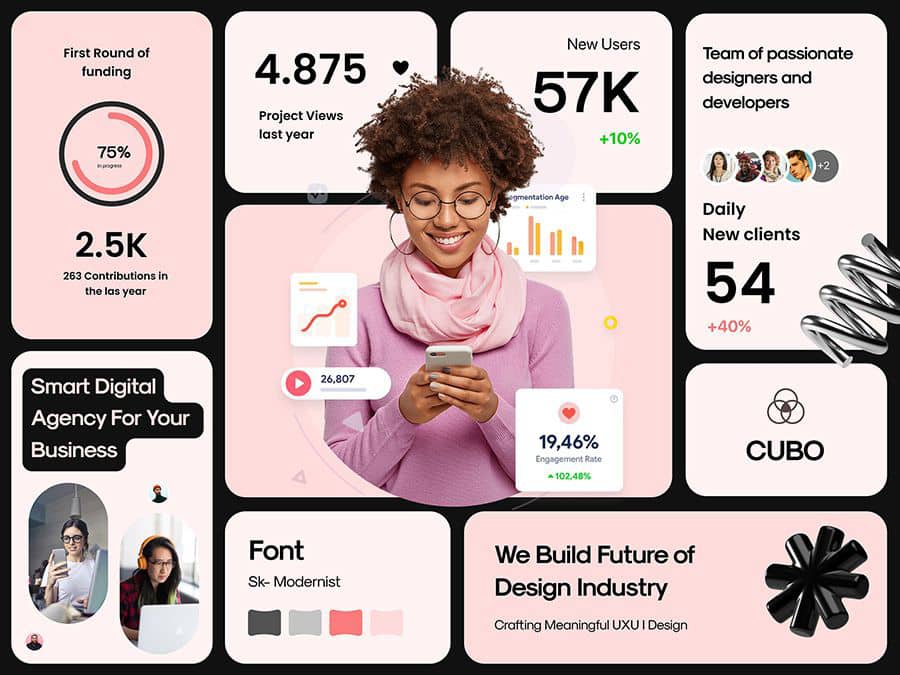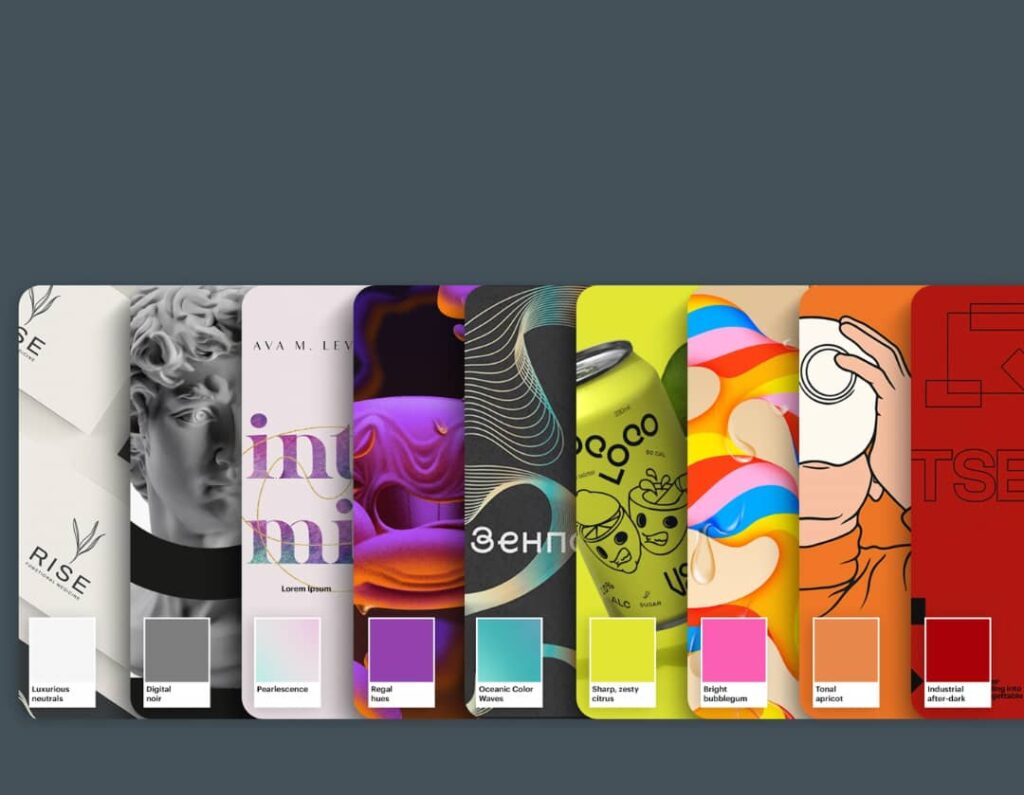
Navigating the web design landscape in Toronto in 2025 reveals a confluence of global trends and local identity. User expectations, a growing focus on sustainability and accessibility, and the city’s unique character are shaping digital aesthetics. Toronto’s tech-savvy and diverse community is filtering global trends through its own cultural, environmental, and economic lenses. Consequently, local web design prioritises not only a modern aesthetic but also usability, meaningful interaction, and a deep resonance with its audience.
Stylistic Trends

Web design is all about creating a user experience that’s both visually striking and highly functional. Here’s how:
- Minimalism 🎨: Designers are creating clean, intentional layouts by stripping away unnecessary elements. They’re using generous white space and a few strong visual elements to magnify content and improve usability. The goal is to make a big impact with less, creating a sophisticated and user-friendly experience.
- Dark mode 🌙: Dark mode has become more of a standard feature. Many websites now offer a dark theme not only for aesthetics but to reduce eye strain and enhance usability in low-light conditions. Some designs even automatically switch based on a user’s device settings or the time of day.
- Bold typography & custom illustrations 🖌️: Brands are moving away from generic stock images and embracing unique visual identities. Designers are creating original illustrations, bespoke graphics, and typography that express a brand’s personality. This approach helps a site stand out in a sea of sleek, minimal designs.
- Immersive design ✨: Scroll-triggered animations, micro-interactions, and 3D elements are enhancing user engagement and storytelling. While these features make interfaces feel dynamic, designers ensure they are well-optimised for performance. A great user experience balances captivating visuals with fast load times.
- Sustainability, ethical design & accessibility 💚: These are no longer optional but essential principles. Designers are creating more energy-efficient websites by optimising images and videos. They are also focusing on WCAG compliance and inclusive design to accommodate various user abilities. Furthermore, ethical UX practices, such as providing clear privacy controls and avoiding manipulative “dark patterns,” are becoming standard.
UX & Interaction Trends

- AI-driven personalisation: Websites are becoming more dynamic, using artificial intelligence to tailor content and layouts to individual users. Pages adapt based on past behaviour, location, and device, offering a more relevant experience. This is especially useful for Toronto businesses serving both local and international visitors.
- Micro-interactions and motion design: Designers are using subtle animations, hover effects, and page transitions to create a smoother, more polished user experience. These small details guide users, provide feedback, and add a sense of professionalism. Scroll-triggered effects and parallax scrolling also highlight important stories or products.
- Voice user interface (VUI) and voice search optimisation: As more people use voice assistants and smart devices, designers are prioritising voice search optimisation. They’re updating metadata and creating conversational content to make sites more accessible and easier to navigate with voice commands. This also improves overall accessibility.
- Enhanced onboarding and error states: Websites are moving beyond generic “404” pages and blank screens. Designers now use custom illustrations and helpful, reassuring messages to guide users through the site, even when something goes wrong. This focus on user-friendliness makes every interaction a positive one.
🍁 Toronto’s Distinct Web Design Scene
Toronto’s web design scene truly reflects its vibrant, multicultural, and urban essence. The city’s immense diversity, with numerous immigrant communities and cultures, directly influences the demand for diverse imagery and content. Designers create websites that showcase real people, incorporate multiple languages, and embrace multicultural aesthetics. You see this approach in the digital presences of businesses in neighbourhoods like Scarborough, Kensington Market, Little Italy, and Chinatown, which all reflect their unique cultural landscapes.
🌿 Sustainability and Local Awareness
Environmental awareness runs deep in Toronto, where sustainability is a local practice, not just a global talking point. Toronto’s businesses and their audiences care about green energy, ethical sourcing, and reducing waste, and this concern extends into their digital practices. Consequently, designers build sites with optimised images and lightweight code. Some even consider carbon-aware hosting, a subtle but impactful nod to the city’s commitment to a greener future.
💸 Budget-Friendly Innovation
While large corporations can afford extravagant immersive effects and bespoke visuals, many of Toronto’s small and medium-sized businesses need to balance aesthetics with a practical budget. This reality drives the popularity of “budget-friendly” design trends. Designers often use lean design systems, reusable assets, and modular approaches to create beautiful, effective websites without breaking the bank. This focus on efficiency allows local businesses to compete visually while remaining financially responsible.
🏙️ Weaving in Local Identity
Toronto’s cultural identity also influences a website’s structure and content. To build trust and connect with local audiences, businesses often embed a sense of place in their designs. They use local cues such as photos of city landmarks or a nod to specific neighbourhoods. Designers also incorporate local colour palettes and acknowledge the seasons, from the crisp feel of autumn to the snowy beauty of winter. These elements ground a brand in its community, making it feel local rather than a generic global entity.
⚖️ Navigating Regulations
Toronto’s unique regulatory environment also shapes the design process. Laws and standards regarding accessibility, privacy, and bilingualism (in specific contexts) mean designers must plan ahead to meet these requirements. This proactive approach ensures that websites are not only visually appealing but also legally compliant and accessible to everyone. The city’s commitment to inclusivity and legal standards directly impacts how designers build their digital experiences.
Challenges & Trade-offs
Web designers in Toronto face various challenges and trade-offs when creating digital experiences. They must constantly balance cutting-edge trends with practical considerations like performance, accessibility, and long-term maintenance. Here’s a closer look at some of those key hurdles.
🐌 Performance and Usability
While trendy features like 3D elements, heavy motion graphics, and AI personalisation can create rich, engaging experiences, they often increase a site’s load time and data consumption. This is a significant challenge in Toronto, where users access the web via a mix of Wi-Fi and cellular networks with varying speeds, and they may be using older devices. As a result, poor performance can severely hamper usability and harm a site’s SEO ranking. Designers must optimise these features or find more lightweight alternatives to ensure a smooth experience for all users, regardless of their connection speed or hardware.
⚖️ Accessibility vs. Aesthetic Novelty
Designers sometimes compromise on accessibility in the pursuit of aesthetic novelty. Certain popular styles, such as neomorphism, extreme transparency, or very low contrast, may look visually stunning but can make a website difficult to read and understand for users with visual impairments. Instead of assuming a design is accessible, designers must explicitly test for it. They need to use accessibility checkers and conduct user testing with real people to ensure their creations are inclusive and usable by everyone.
🛠️ Uniqueness and Maintainability
Creating a unique website often comes at the cost of long-term maintainability. Custom illustrations, bespoke animations, or complex AI-based experiences require more significant engineering effort and can result in higher maintenance costs over time. For Toronto’s many small businesses and solo designers, this trade-off can be a major constraint. They must weigh the benefits of a one-of-a-kind design against the practicality of a more maintainable, scalable solution.
💻 Ensuring Cross-Platform Consistency
Staying ahead of browser compatibility and ensuring a consistent experience across new devices (desktops, mobile phones, and tablets) remains a constant struggle. A website that performs flawlessly on a high-end device may fail on an older one if the designer hasn’t conducted thorough testing across various user contexts. Designers must continuously test their work to guarantee a beautiful and functional experience, regardless of how or where a user accesses the site.
Strategic Recommendations for Toronto Designers & Businesses
- Know your audience: Begin every project by gaining a clear understanding of your audience. Consider what devices they use, their internet speeds, language preferences, and cultural expectations. This research will help you determine which design trends are most relevant and effective for your specific market.
- Prioritise performance & accessibility: Make website performance and accessibility non-negotiable from the get-go. Utilise tools like Lighthouse audits to measure site speed and efficiency, set web performance budgets to keep designs lean, and use contrast checkers to ensure your site is readable for everyone.
- Adopt modular design systems: Embrace modular design to achieve both flexibility and efficiency. By reusing UI components, maintaining a well-documented style guide, and balancing custom elements with reusable ones, you can significantly reduce costs while ensuring a consistent user experience across your site.
- Test with local users: Don’t just rely on trends; get feedback from actual local users. A modern-looking site won’t resonate if its imagery or content feels generic or disconnected from Toronto’s unique local culture. Conduct usability tests with people from diverse backgrounds across the city to make sure your design feels authentic and relevant.
- Integrate sustainability: Weave sustainability into your design decisions. Optimising assets, choosing efficient hosting, and reducing unnecessary data transfer are not just ethical practices—they’re increasingly expected by eco-conscious audiences and can help your brand stand out.
Conclusion
Web design in Toronto stands at a unique crossroads in 2025. While global trends like minimalism, immersive visuals, and AI personalisation are now mainstream, what truly sets Toronto’s sites apart is their thoughtful adaptation to local needs.
Designers localise these trends to create experiences that champion inclusivity, reflect the city’s vibrant cultural identity, and deliver exceptional performance in diverse settings. The most successful designs strike a clever balance between ambition and practicality, ensuring they are both innovative and budget-friendly for local businesses.